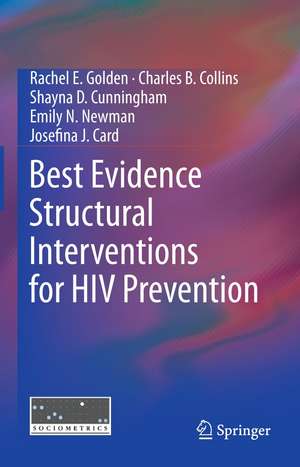Best Evidence Structural Interventions for HIV Prevention
Autor Rachel E. Golden, Charles B. Collins, Shayna D. Cunningham, Emily N. Newman, Josefina J. Carden Limba Engleză Paperback – 22 iun 2015
| Toate formatele și edițiile | Preț | Express |
|---|---|---|
| Paperback (1) | 1097.91 lei 6-8 săpt. | |
| Springer – 22 iun 2015 | 1097.91 lei 6-8 săpt. | |
| Hardback (1) | 1104.84 lei 6-8 săpt. | |
| Springer – 24 mai 2013 | 1104.84 lei 6-8 săpt. |
Preț: 1097.91 lei
Preț vechi: 1155.69 lei
-5% Nou
Puncte Express: 1647
Preț estimativ în valută:
210.08€ • 219.36$ • 173.48£
210.08€ • 219.36$ • 173.48£
Carte tipărită la comandă
Livrare economică 15-29 aprilie
Preluare comenzi: 021 569.72.76
Specificații
ISBN-13: 9781489997463
ISBN-10: 1489997466
Pagini: 360
Ilustrații: VIII, 352 p.
Dimensiuni: 155 x 235 x 19 mm
Greutate: 0.51 kg
Ediția:2013
Editura: Springer
Colecția Springer
Locul publicării:New York, NY, United States
ISBN-10: 1489997466
Pagini: 360
Ilustrații: VIII, 352 p.
Dimensiuni: 155 x 235 x 19 mm
Greutate: 0.51 kg
Ediția:2013
Editura: Springer
Colecția Springer
Locul publicării:New York, NY, United States
Public țintă
ResearchDescriere
In the fourth decade of the HIV epidemic, the signs are both encouraging and alarming: fewer people are dying, and more people are living longer with the help of powerful antivirals, yet many areas of the world are seeing new cases on the rise.
Best Evidence Structural Interventions for HIV Prevention reports on successful HIV prevention initiatives from across the globe, representing countries in Europe, Asia, Africa, and the Americas at diverse stages of the epidemic. Spotlighting major worldwide objectives--decreasing risks in IV drug use, commercial sex work, and non-commercial sexual activity and promoting HIV screening, voluntary counseling and testing (VCT), and antiretroviral therapy--these rigorously evaluated interventions are analyzed at individual and community levels. Chapters discuss issues regarding availability and accessibility of resources and populations' receptivity to change. And the authors examine related ethical challenges, including whether interventions should also target larger problems fueling the epidemic such as poverty and inequality. Among the programs featured:
These life-saving initiatives are worthy of wider recognition, making Best Evidence Structural Interventions for HIV Prevention a superior reference for graduate students and researchers in public health, HIV/AIDS prevention, and health policy. Policymakers and planners will also find these ideas of great importance.
Best Evidence Structural Interventions for HIV Prevention reports on successful HIV prevention initiatives from across the globe, representing countries in Europe, Asia, Africa, and the Americas at diverse stages of the epidemic. Spotlighting major worldwide objectives--decreasing risks in IV drug use, commercial sex work, and non-commercial sexual activity and promoting HIV screening, voluntary counseling and testing (VCT), and antiretroviral therapy--these rigorously evaluated interventions are analyzed at individual and community levels. Chapters discuss issues regarding availability and accessibility of resources and populations' receptivity to change. And the authors examine related ethical challenges, including whether interventions should also target larger problems fueling the epidemic such as poverty and inequality. Among the programs featured:
- U.S.: Legal access to needles and syringes.
- China: Needle social marketing.
- Tanzania: Go with the Times, a radio soap opera.
- Dominican Republic: Compromiso Collectivo for female sex workers.
- France: Prenatal HIV screening.
- South Africa: Drama-based intervention to promote VCT.
These life-saving initiatives are worthy of wider recognition, making Best Evidence Structural Interventions for HIV Prevention a superior reference for graduate students and researchers in public health, HIV/AIDS prevention, and health policy. Policymakers and planners will also find these ideas of great importance.
Cuprins
Introduction.- Chapter 1.Overview of Interventions to Decrease Injection Drug Use Risk.- Case Study 1 Legalization of Needle and Syringe Sale and Possession:Effect on Connecticut Injection Drug Users’ Injection Practices.- Case Study 2 The SHAKTI Intervention in Bangladesh:(Stopping HIV/AIDS through Knowledge and Training Initiatives)A Needle Exchange Program’s Effect on Injection Drug Users’ Injection.- Case Study3 Providing a Safer Injection Facility to Injection Drug Users: InSite: A Safer Injection Facility in Vancouver, British Columbia.- Case Study 4 Needle Social Marketing Strategy in China: Effect on Chinese Injection Drug Users’ Injection Practices.- Case Study 5 The Vietnam and China Cross-Border Project: Effect on HIV Risk Behaviors of Injection Drug Users.- Chapter 2 History and Politics of Structural Change to Reduce HIV Due to Non-Commercial Sex Risk.- Case Study 6 Louisiana’s Condom Social Marketing Program: Effect of Improved Availability and Access on Use.- Case Study 7 Promoting Sexual Responsibility Among Youth in Zimbabwe: Effect of an Extensive Multimedia Campaign on Indicators of Safer Sex.- Case Study 8 The 100% Jeune Social Marketing Campaign: Effect on Condom Use among Youth in Cameroon.- Case Study 9 Twenda na Wakati (Lets Go with the Times):Effects of a Radio Soap Opera on HIV/AIDS Prevention in Tanzania.- Case Study 10 A Safer Sex Media Campaign in Lexington, Kentucky: Using Public Service Announcements to Promote Condom Use.- Chapter 3 Overview of Structural Interventions to Decrease Commercial Sex Risk.- Case Study 11 Mandatory Condom Law in Nevada Brothels: Using Policy to Change Condom Use Practices.- Case Study 12 Compromiso Collectivo: Reducing HIV Risk among Female Sex Workers in the Dominican Republic.- Case Study 13 A Social and Structural Intervention in the Philippines: Effect on Condom Use of Establishment-Based Female Sex Workers.- Case Study 14 The 100% Condom Program in Thailand: Using Public Policy Change to Increase Condom Use in Brothels.- Case Study 15 The Sonagachi Project: Empowering Sex Workers in the Songagchi District of Calcutta, India.- Chapter 4 Overview of Structural Interventions to Increase Voluntary Counseling and Testing(VCT) and Antiretroviral Therapy (ART).- Case Study 16 Mandatory Offering of HIV Screening during Prenatal Visits: The Experience of Southeastern France in Response to National Policy.- Case Study 17 Free Highly Active Antiretroviral Therapy in Taiwan: Effect of a Country-Wide Policy on HIV Transmission.- Case Study 18 A Drama-Based HIV Intervention in South Africa: Effect on Voluntary Counseling and Testing.- Conclusion.
Recenzii
From the reviews:
“This volume, which details the evidence for structural interventions, is a resource to service providers, planners, policy makers, and funders. … of interest to academics, nongovernmental organization workers, policy makers, economists, and others interested in addressing the HIV pandemic at a population level. … As a reference for practitioners in HIV prevention, this volume should be a first port of call. It is an important contribution to the field.” (Ashraf Kagee, PsycCRITIQUES, Vol. 59 (11), March, 2014)
“This volume, which details the evidence for structural interventions, is a resource to service providers, planners, policy makers, and funders. … of interest to academics, nongovernmental organization workers, policy makers, economists, and others interested in addressing the HIV pandemic at a population level. … As a reference for practitioners in HIV prevention, this volume should be a first port of call. It is an important contribution to the field.” (Ashraf Kagee, PsycCRITIQUES, Vol. 59 (11), March, 2014)
Notă biografică
Rachel E. Golden, Dr.P.H., M.P.H. joined Sociometrics Corporation in 2010 as a Senior Research Associate. In her role, Dr. Golden examines and compares HIV/AIDS prevention programs and focuses on the development and evaluation of health promotion projects and program replication for diverse populations. In addition, she is Vice Chair of Sociometrics’ IRB. Before coming to Sociometrics, Dr. Golden worked for the Los Angeles County (LAC) Department of Public Health, where she oversaw the LA Health Overview of a Pregnancy Event Project, focusing on fetal and infant mortality. She also supported the LAC Action Learning Collaborative Partnership to Eliminate Disparities in Infant Mortality, and assisted the LA Mothers and Babies Project. Prior to that she served as a grant-writer and program evaluator for the Rescatando Salud/Health Rescue Promotora Project, housed in the LAC Department of Health Services.
Charles B Collins, Jr. Ph.D. is the Team Leader of the Science Application Team, Capacity Building Branch, National Center for HIV, STD and TB Prevention, Centers for Disease Control and Prevention. His team of scientists is responsible for the dissemination of evidence-based behavioral interventions into HIV prevention practice. His team is working with 26 evidence-based interventions designated as having the highest evidence of efficacy for HIV prevention. Over the last 8 years, these interventions have been disseminated to over 3900 community-based prevention agencies; to over 900 city, county, and state health departments; and to over 1100 medical clinics.
Charles B Collins, Jr. Ph.D. is the Team Leader of the Science Application Team, Capacity Building Branch, National Center for HIV, STD and TB Prevention, Centers for Disease Control and Prevention. His team of scientists is responsible for the dissemination of evidence-based behavioral interventions into HIV prevention practice. His team is working with 26 evidence-based interventions designated as having the highest evidence of efficacy for HIV prevention. Over the last 8 years, these interventions have been disseminated to over 3900 community-based prevention agencies; to over 900 city, county, and state health departments; and to over 1100 medical clinics.
Textul de pe ultima copertă
Best Evidence Structural Interventions for HIV Prevention
Rachel E. Golden, Charles B. Collins, Shayna D. Cunningham, Emily N. Newman, and Josefina J. Card
In the fourth decade of the HIV epidemic, the signs are both encouraging and alarming: fewer people are dying, and more people are living longer with the help of powerful antivirals, yet many areas of the world are seeing new cases on the rise.
Best Evidence Structural Interventions for HIV Prevention reports on successful HIV prevention initiatives from across the globe, representing countries in Europe, Asia, Africa, and the Americas at diverse stages of the epidemic. Spotlighting major worldwide objectives--decreasing risks in IV drug use, commercial sex work, and non-commercial sexual activity and promoting HIV screening, voluntary counseling and testing (VCT), and antiretroviral therapy--these rigorously evaluated interventions are analyzed at individual and community levels. Chapters discuss issues regarding availability and accessibility of resources and populations' receptivity to change. And the authors examine related ethical challenges, including whether interventions should also target larger problems fueling the epidemic such as poverty and inequality. Among the programs featured:
These life-saving initiatives are worthy of wider recognition, making Best Evidence Structural Interventions for HIV Prevention a superior reference for graduate students and researchers in public health, HIV/AIDS prevention, and health policy. Policymakers and planners will also find these ideas of great importance.
Rachel E. Golden, Charles B. Collins, Shayna D. Cunningham, Emily N. Newman, and Josefina J. Card
In the fourth decade of the HIV epidemic, the signs are both encouraging and alarming: fewer people are dying, and more people are living longer with the help of powerful antivirals, yet many areas of the world are seeing new cases on the rise.
Best Evidence Structural Interventions for HIV Prevention reports on successful HIV prevention initiatives from across the globe, representing countries in Europe, Asia, Africa, and the Americas at diverse stages of the epidemic. Spotlighting major worldwide objectives--decreasing risks in IV drug use, commercial sex work, and non-commercial sexual activity and promoting HIV screening, voluntary counseling and testing (VCT), and antiretroviral therapy--these rigorously evaluated interventions are analyzed at individual and community levels. Chapters discuss issues regarding availability and accessibility of resources and populations' receptivity to change. And the authors examine related ethical challenges, including whether interventions should also target larger problems fueling the epidemic such as poverty and inequality. Among the programs featured:
- U.S.: Legal access to needles and syringes
- China: Needle social marketing
- Tanzania: Go with the Times, a radio soap opera
- Dominican Republic: Compromiso Collectivo for female sex workers
- France: Prenatal HIV screening
- South Africa: Drama-based intervention to promote VCT
These life-saving initiatives are worthy of wider recognition, making Best Evidence Structural Interventions for HIV Prevention a superior reference for graduate students and researchers in public health, HIV/AIDS prevention, and health policy. Policymakers and planners will also find these ideas of great importance.
Caracteristici
Comprehensive resource of structural intervention case studies from around the world ?
Emphasis is on adapting evidence-based interventions to save time and money, while increasing the likelihood of successful outcomes
Includes online supplementary materials
Includes supplementary material: sn.pub/extras
Emphasis is on adapting evidence-based interventions to save time and money, while increasing the likelihood of successful outcomes
Includes online supplementary materials
Includes supplementary material: sn.pub/extras













